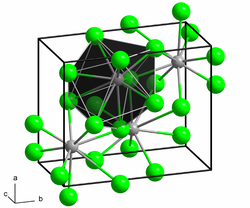Samarium (II) bromide
| Crystal structure | |||||||||||||
|---|---|---|---|---|---|---|---|---|---|---|---|---|---|

|
|||||||||||||
| __ Sm 2+ __ Br - | |||||||||||||
| General | |||||||||||||
| Surname | Samarium (II) bromide | ||||||||||||
| other names |
Samarium dibromide |
||||||||||||
| Ratio formula | SmBr 2 | ||||||||||||
| Brief description |
red-brown solid |
||||||||||||
| External identifiers / databases | |||||||||||||
|
|||||||||||||
| properties | |||||||||||||
| Molar mass | 310.17 g mol −1 | ||||||||||||
| Physical state |
firmly |
||||||||||||
| Melting point |
669 ° C |
||||||||||||
| boiling point |
1250 ° C |
||||||||||||
| safety instructions | |||||||||||||
|
|||||||||||||
| As far as possible and customary, SI units are used. Unless otherwise noted, the data given apply to standard conditions . | |||||||||||||
Samarium (II) bromide is an inorganic chemical compound of samarium from the group of bromides .
Extraction and presentation
Samarium (II) bromide can be obtained by reducing samarium (III) bromide with samarium in a vacuum at 800 to 900 ° C.
It is also possible to produce it by thermal decomposition of samarium (III) bromide at 200 ° C. with relatively large losses due to disproportionation.
The compound was first synthesized in 1934 by Selwood by reducing samarium (III) bromide with hydrogen at 740 ° C.
Synthesis methods from samarium (III) oxide or from lithium bromide and samarium (II) iodide in tetrahydrofuran or by reacting samarium with 1,1,2,2-tetrabromoethane were later developed.
properties
Samarium (II) bromide is a red-brown solid. The connection is extremely hygroscopic and can only be stored and handled under carefully dried protective gas or in a high vacuum. In air or in contact with water, it changes into hydrates while absorbing moisture , but these are unstable and more or less quickly turn into oxide bromides with evolution of hydrogen . The compound has a crystal structure of the strontium bromide type or lead (II) chloride type.
use
Samarium (II) bromide is in organic chemistry, for example, to pinacol - homocoupling of aldehydes and ketones and cross-coupling of carbonyl compounds employed, it has as the commonly used samarium (II) iodide in these reactions better properties. It is used as a reducing agent.
Individual evidence
- ↑ a b c d e f g Georg Brauer (Ed.), With the collaboration of Marianne Baudler u. a .: Handbook of Preparative Inorganic Chemistry. 3rd, revised edition. Volume I, Ferdinand Enke, Stuttgart 1975, ISBN 3-432-02328-6 , p. 1081.
- ↑ This substance has either not yet been classified with regard to its hazardousness or a reliable and citable source has not yet been found.
- ^ A b c David J. Procter, Robert A. Flowers, Troels Skrydstrup: Organic Synthesis Using Samarium Diiodide: A Practical Guide . Royal Society of Chemistry, 2010, ISBN 1-84755-110-6 , pp. 157 ( limited preview in Google Book search).
- ↑ Andreas P. Zörb: Samarium (II) -halide-mediated alpha-defunctionalization of protected ... Lulu.com, 2010, ISBN 1-4461-2753-2 , p. 62 ( limited preview in Google Book search).


